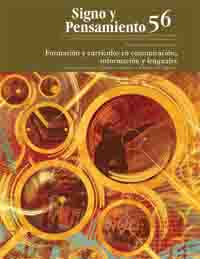Resumo
Neste artigo, investigamos diferentes modelos pedagógicos de educação no mundo, apoiados pelas Tecnologias de Informação e Comunicação (TIC) e seu impacto, para criar um Modelo de Aprendizado Virtual para o Ensino Superior na Colômbia em Tecnologias Web 2.0.
Utilizamos pesquisa teórica e aplicada, qualitativa e quantitativa, sob a modalidade de estudos descritivos e correlacionais. O modelo foi implementado e validado em dois anos acadêmicos. Seu método consistiu em aprender fazendo a partir de uma abordagem sócio-construtivista: ler-escrever-construir-publicar em repositórios digitais da Internet, conteúdos colaborativos e a autoria do aluno, de acordo com seu conhecimento prévio, pensamento crítico e seu contexto social, através de novas mediações pedagógicas e estratégias de comunicação e interação em comunidades virtuais de aprendizagem.
Ausubel, D. y Robinson, F. (1999), School Learning: and Introduction to Educational Psychology, New York, Holt, Rinehart and Winston.
Bell, D. (1973), El advenimiento de la sociedad post-industrial, Madrid, Alianza.
Bruner, J. S. (1973), Beyond the Information Given, Nueva York, Norton.
Castells, M. (1997), La era informacional. Economía, sociedad y cultura (vol. 1, La sociedad red), Madrid, Alianza Editorial.
— (1999), “Flows, Networks, and Identities: a Critical Theory of the Information Society”, en Castells, M. et al., Critical Education in the New Information Age, Nueva York, Rowman y Littlefield Publishers.
Domínguez, G. (2008), Perspectiva de la universidad en la escena contemporánea, Chimbote, Perú, Uladech.
Edwards, J. D. (2008), Gestión del conocimiento: conceptos y estrategias, Madrid, Alianza.
Fundación Gabriel Piedrahita Uribe (2007), Modelo y metodología Gavilán para desarrollar la competencia para manejar información (cmi) [en línea], disponible en http://www.ribiecol.org/index2. php?option=com_docman&task=doc_ view&gid=27&Itemid=15, recuperado: 30 de agosto de 2008.
Gagné, E. (1998), “Long-term retention of infor- mation following reading from prose”, Review of Educational Research.
Hepp, P. (1999), “Enlaces: todo un mundo para los niños y jóvenes de Chile”, en García-Huidobro, J., La reforma educacional chilena, Madrid, Popular.
Joyanes, L. (2003), Congreso ‘La aplicación de las tecnologías de la información y la comunicación en los centros educativos’, Madrid, Departamento de Lenguaje y Sistemas Informáticos, Universidad Pontificia de Salamanca.
— (1997), Cibersociedad. Los retos sociales ante un nuevo mundo digital, Madrid, McGraw-Hill. Lave, J. (1998), “Cognition in practice: mind, mathematics and in everyday life”, en Situated Learning: Legitimate Peripheral Participation,
Cambridge, Cambridge University. Martínez, J. (2002), Contenidos en e-learning: el rey sin corona [en línea], disponible en http:// www.uoc.edu/dt/20126/index.html, recuperado: 07 de noviembre de 2008.
Monereo, C. (2007), Las estrategias de aprendizaje: preguntas básicas para la integración en la programación didáctica, Madrid, Visor.
Negroponte, N. (1995), Ser digital: el futuro ya está aquí, y solo existen dos posibilidades: ser digital o no ser, Buenos Aires, Atlántida.
Oshima, J.; Bereiter, C., y Scardamalia. M. (1995), “Onformation-Acces Characteristics for High Conceptual Progress in a Computer-Networked Learning Environment” en: Computer support for collaborative learning. Proceedings of the 2005 conference on Computer support for collaborative learning: learning 2005: the next 10 years! [en línea], disponible en: http://portal. acm.org/toc.cfm?id=1149293&type=proceed ing&coll=GUIDE&dl=GUIDE&CFID=89 491836&CFTOKEN=14380253, recuperado: 10 de noviembre de 2008.
Piaget, J. (1999), De la pedagogía, Buenos Aires, Paidós.
Sánchez, J. (1999), “Usos educativos de Internet”, en Enlaces, núm. 18, año 5, Instituto de Informática Educativa, Universidad de La Frontera, pp. 32-39.
Spiro, J. R. et al. (1998), “Cognitive flexibility theory: advances knowledge acquisition in ill-structurent domains”, en Patel Hills-Dale, V. y Eribaum, N. J., Theoretical models and processes of reading, 4.a ed., Newark, International Reading Association.
Taylor, S. y Bogdan, R. (1984), Introducción a los métodos cualitativos de investigación, Barcelona, Paidós.
Tinker, R. (2008), “E-learning quality: the concord model for learning from a distance”, NASSP Bulletin, vol. 85, núm. 628, pp. 37-46.
Tiwana, A. (2002), The Knowledge Management Toolkit. Practical Techniques for Building a Knowledge Management System, 2.a ed., Upper Saddle River, Prentice Hall.
Toffler, A. (2001), La tercera ola, Barcelona, Plaza y Janés.
Vygotsky, L. (1995), Pensamiento y lenguaje, Barcelona, Paidós.
Weinstein, J. (1999), “El proyecto Montegrande”, en García-Huidobro, J., La reforma educacional chilena, Madrid, Popular.
Esta revista científica está registrada sob a licença Creative Commons Attribution 4.0 International. Portanto, este trabalho pode ser reproduzido, distribuído e comunicado publicamente em formato digital, desde que os nomes dos autores e da Pontificia Universidad Javeriana sejam mencionados. Você pode citar, adaptar, transformar, auto-arquivar, republicar e desenvolver o material, para qualquer finalidade (inclusive comercial), desde que reconheça adequadamente a autoria, forneça um link para o trabalho original e indique se foram feitas alterações. A Pontificia Universidad Javeriana não retém os direitos sobre os trabalhos publicados e o conteúdo é de responsabilidade exclusiva dos autores, que mantêm seus direitos morais, intelectuais, de privacidade e publicidade.


